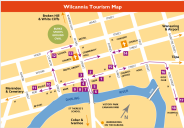"Middle of nowhere, centre of everywhere"
Historical, Business and Service Overview, Wilcannia
Posted by Admin on Wed, 22/Jan/2014 - 7:37pm
Historical Overview
- Athenaeum (1884): had the youngest son of Charles Dickens, Edward Dickens on original committee. Wilcannia Cricket Club at one time had two of Charles Dickens sons and a son of another English author Anthony Trollope, as members.
- Knox and Downs (1890): where you could buy everything from a boiled lolly to a Southern Cross Windmill. The original sandstone building, with full cellar and jarrah staircase burnt down in 2002.
- Wilcannia Club Hotel(1879): on the site of Wilcannia’s first hotel. Originally called the “Five Alls” from the old English Joke:
First — The Clergyman — I pray for all
Second — The Lawyer — I plead for all
Third — The Doctor — I heal all
Fourth — The Soldier — I fight for all
Fifth — The Farmer — I pay for all.” - Post Office: Contructed in 1879, restored through government grants in 2010. Reopened in November 2013.
- Rowing Club: some of the sculls are still stored in the Riverfront Warehouse, now in private ownership.
- Wilcannia was the third largest port in NSW after Sydney and Morpeth near Newcastle. In 1887 218 vessels arrived in Wilcannia with 36,170 tons of goods and 222 left with 26,552 tons.
- The Original Bridge was opened in 1896. When it was first built there were a lot of sheep on the road (drovers). In the early 1900’s an old woman lived near the bridge and had a pet sheep that she would hire out at 10 pound a time to lead the drovers mobs across the bridge. In the 1950s this job was done by Herbie Milne who had a couple of poddy lambs. He charged 10 shillings ($1).
- Major Mitchell was the first known white man to come into contact with the Barkindji near Wilcannia in 1835.
- Bullocks, camels, horses and donkeys all played a part in opening up the outback.
- Police Complex c1881: Wilcannia had a long term jail before Broken Hill. At one time there was a night watchman who called the time as he did his rounds of the cell block.
- River Front Warehouse: a shepherds hut originally stood on this site as an outstation of Mount Murchison Station. It was the shipping and transport hub of the district.
- Wilcannia School: the first teachers were paid £1.10.0 per week. ($190.44 in today’s $ adjusted for inflation). There was a fairly high turn over of teachers as they often found the conditions a little primitive for their liking.
- St James Church (1883): the bell tower was donated by the Leckie family in memory of Robert Leckie, 17th Battalion, who was killed in action in the Great War. His name is on the Memorial Wall, Menin Gate, Belgium.
- Catholic Convent (1894): home of the Sisters of Mercy for many years. Some of the original Sisters came to Wilcannia straight from Ireland. Sister Veronica from County Queens in Ireland came here in 1891 and cooked for boarders and sisters until the mid 1950’s before retiring to Sydney.
- London Standard Chartered Bank (1887): now the Shire Chambers with fine views of the town from the balcony. Upstairs was the residence for the bank manager. The original safe is still in the front room, the door costing £800 in its day.
- RESCH’s Red Lion Brewery (c1890): first a soft drink factory. At one time they used oval bottles which are still sometimes found in the river bed. They can sell for up to $80 if in good condition. Now Wilcannia Golf Club.
- Old Town Water Supply: the tower, no longer used, is heritage listed. The steam engines were rescued from the river bank a couple of years ago. The town weir is located a little downstream from the hospital and can be viewed from the end of the dirt road between the old brick home (the Brewery House) and the Homecare building. The weir was built between 1942 to 1947 and is now in a poor state of repair.
- Hospital (1879): a magnificent building that has been added to, taken from and added to a couple of times. The latest award winning renovation gives patients the option of river or courtyard views.
Photo Gallery:



